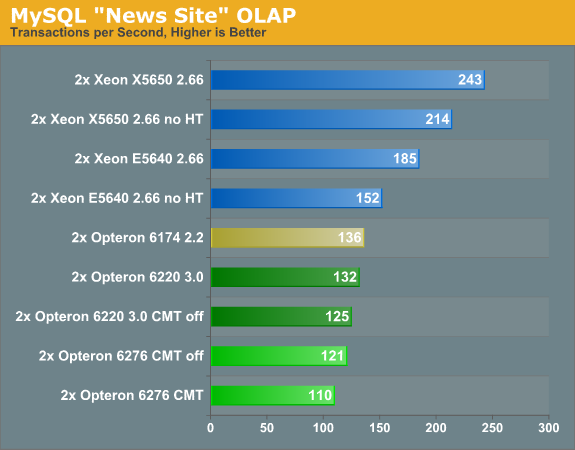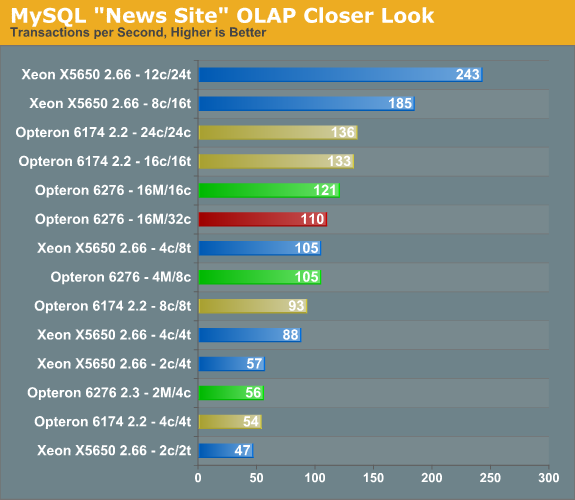The Opteron 6276: a closer look
by Johan De Gelas on February 9, 2012 6:00 AM EST- Posted in
- IT Computing
- CPUs
- Bulldozer
- AMD
- Opteron
- Cloud Computing
- Interlagos
MySQL 5.5.17 "Percona Server"
Many readers asked us why we only tested MySQL in a virtualized environment and not on "native" Linux. Indeed, it has been years since we tested MySQL "natively". The reason is simple: MySQL 5.1 and earlier versions scaled pretty badly beyond 4-8 cores, so there is no incentive to run them on modern dual socket servers. However, starting in December 2010, MySQL 5.5 has been available and it should feature much improved scalability. Even better, the people at Percona released their version of MySQL and the Innodb Storage Engine, Percona Server with XtraDB. This MySQL/Innodb combination is engineered for even better scalability.
To test this, we installed Percona Server 5.5.17-55 (Release 22.1, November 2011) on top of a Ubuntu 11.10 x86-64 linux with the 3.0.0-14 kernel. This kernel was the latest stable version at the time and is "Bulldozer/Interlagos aware".
We migrated the "Nieuws.be" database to MySQL to have a test similar to our SQL server test. That migration is not perfect as not all stored procedures were successfully converted, so you should not use the benchmark results below to compare SQL Server and MySQL. However, the profile of the test is the same: it is 99% complex selects that scan large parts of the database. The database is several tens of gigabytes instead of one.

The results are abysmal for the latest Interlagos Opteron. The best Xeon score is 84% better than the best Opteron score. The results indicate what went wrong: the 8 thread Opteron 6220 at 3GHz scores better than the 16 thread Opteron 6276 at 2.3GHz. A clockspeed advantage of 30% has prevailed over twice as many threads. So we can suspect that the scaling problems are not gone, at least in this test.
Let us take a closer look by performing the same test on a different number of threads and cores. The BIOS of the SuperMicro H8DGU-F allowed us to disable the second integer unit or one or more modules of the new Opterons. (Disabling both at the same time was not possible.) The Asus Z8PS-D12-1U was more flexible: we could disable Hyper-Threading and/or several cores of the Xeon. Here are the scaling results.

First, we focus on the results with few cores and threads. Two Bulldozer Modules are capable of slightly outperforming four cores of the Opteron Magny-Cours. The ideas behind Bulldozer are sound: two modules are smaller (157 mm²) and more power efficient than four K10 cores (231 mm²). At the same time they perform equal to the Xeon X5650—which is clocked higher—with the same amount of threads. At eight threads this is still the case, and the gap between the newer and older Opteron widens in favor of the former.
Beyond eight threads, the new Opteron starts to scale badly. Doubling the number of modules to eight delivers a very small 5% performance advantage. Double the number of modules again and you end up with negative scaling. To make matters worse, the Xeon doesn't have this problem. From eight to 16 threads we get a 76% performance boost. The end result is that a quad-core Xeon beats the best Opteron by a large margin. Let us investigate the matter further.










46 Comments
View All Comments
Scali - Saturday, February 11, 2012 - link
"It also reduces throughput."No, it improves throughput, assuming we are talking from improvement going from 1 physical core to 2 logical cores.
Clearly two logical cores (on the same physical core) have less throughput than two physical cores, but that's obvious since you only have half the hardware.
And that, together with the fact that Intel's SMT chips have far better single-threaded performance to begin with, results in very good performance per die area (you know, that thing that people used to praise AMD GPUs for).
"Yes, it does, via the implementation of all that shared hardware on the chip."
You can't say that, since there is no non-modular version of Bulldozer (just as there is no non-HT version of the Intel architectures).
However, if you compare a 4-core HT architecture with a non-HT architecture, be that a Core2 Quad or a Phenom X4, Intel's transistorcount is clearly in the same ballpark, so HT does not add much in terms of transistorcount.
With CMT we see little or no indication of reduced transistorcount. AMD's 4-module chips are MUCH larger than regular 4-core chips have been. In fact, AMD"s 4-module design is even larger than Intel's 6-core design with HT.
"Two different approaches to the same idea."
I disagree. SMT is a very different idea from CMT (which is a bogus marketing term invented by AMD anyway). CMT is more of a marketing excuse for not having proper SMT, and shows no merit in actual silicon.
"but I don't think we can label one as inherently better than the other yet."
Well clearly we disagree on that then.
I think SMT is clearly inherently better than CMT. SMT has far more flexible sharing of resources than AMD's half-baked approach.
And any theoretical disadvantages (fighting over resources and all that) can be put to bed with benchmarking such as in this review: the disadvantages may exist, but the net performance is unbeatable anyway. A midrange Xeon schools a CMT-based chip of twice the size.
Andexxx - Wednesday, February 15, 2012 - link
Well, there are a lot of factors affecting single-threaded performance in real life. So CMT indeed has its scaling advantages as tests suggested. At least most of the things should be constant when comparing CMT-on and CMT-off, while comparing SMT and CMT on different implementations is not. Lack of single-threaded performance is not a valid point of blaming CMT.If you want to *proof* CMT is a half-baked marketing crap while SMT is the only solution, what you need is a SMT-based AMD BD monolithic core or a CMT-based Intel monolithic module for comparison.
For the transistors counting, well, that's their choice of making such a cache and uncore configuration. You can keep telling 4-module chip is blahblahblah, but in some cases it beats a 4C8T Xeon chips. Transistors is not a big matter from customer viewpoint but just the producer viewpoint. If you want to argue with GPU's performance metrics, GPU is a data-parallel processor with bunch of logic units, while CPU is a latency-sensitive girlfriend of caches. Large amount of cache can make your Performance/mm^2 or Performance/transistors look worse. So trade-offs on the amount of cache should have been done before they started to design the chip.
Scali - Wednesday, February 15, 2012 - link
Well, one of the reasons why AMD's current CPUs have such poor single-threaded performance is because they moved from 3 ALUs per thread to 2 ALUs per thread.This is part of the whole CMT design.
So in that sense, CMT can be blamed for the poor single-threaded performance at least.
And since single-threaded performance is so bad, it is only logical that scaling to more threads is relatively good.
On a CPU with faster single-threaded performance, you run into IO limits sooner (memory, disk etc), so it is more difficult to maintain similar scaling with increased thread count.
The strength of SMT is that Intel did not have to cut any ALUs when implementing HT. Pentium 4 Northwood with HT still had two double-pumped ALUs, like the non-HT Willamette that went before it.
Likewise, Core i7 still has 3 ALUs, like Core2.
Another strength of SMT is that even with one less ALU per 2 threads than CMT, it still reaches similar performance in multithreaded scenarios. CMT can not share these ALUs between threads, while SMT can.
Conclusion: CMT is nonsense.
For the full version, see: http://scalibq.wordpress.com/2012/02/14/the-myth-o...
slycer.tech - Monday, February 13, 2012 - link
If Bulldozer arc really bad, how about this?http://www.marketwatch.com/story/amd-opterontm-620...
Can someone prove this award is a big liar?
duploxxx - Tuesday, February 14, 2012 - link
read the article, the baseline they use for price/performance is based on spec results....lots of companies still use these results to decide on a platform.but then again, benchmarks don't always show the real world value or even hard to compare since many have in house applications that don't scale or scale different like the ones benchmarked in reviews. 90% of the datacenters don't even require more then any midrange cpu, anything above midrange is wasted money and both vendors provide more then adequate solutions to that. It's the human mind that is often blocking sanity. Investing that wasted money in other solutions often provide a better total performing solution.
anti_shill - Monday, April 2, 2012 - link
shill_detector by anti_shill on Monday, April 02, 2012Here's a more accurate reflection of Bulldozer/ interlagos performance, untainted by intel ad bucks...
http://www.phoronix.com/scan.php?page=article&...
But if u really want to see what the true story is, have a look at AMD's stock price lately, and their server wins. They absolutely smoke intel on virtualization, and anything that requires a lot of threads. It's not even close.